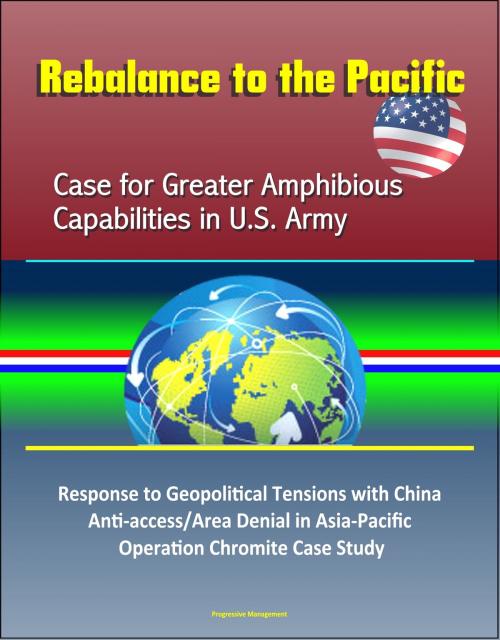Rebalance to the Pacific: Case for Greater Amphibious Capabilities in U.S. Army – Response to Geopolitical Tensions with China, Anti-access/Area Denial in Asia-Pacific, Operation Chromite Case Study
Nonfiction, History, Asian, China, Military, United States| Author: | Progressive Management | ISBN: | 9781370200702 |
| Publisher: | Progressive Management | Publication: | February 26, 2017 |
| Imprint: | Smashwords Edition | Language: | English |
| Author: | Progressive Management |
| ISBN: | 9781370200702 |
| Publisher: | Progressive Management |
| Publication: | February 26, 2017 |
| Imprint: | Smashwords Edition |
| Language: | English |
This excellent report has been professionally converted for accurate flowing-text e-book format reproduction. The United States is in the midst of rebalancing towards the Asia-Pacific region. This shift in national focus and strategy requires a careful examination of current US military concepts and capabilities to protect US interests and ensure regional stability. However, the security environment in the Pacific is not as benign as some studies might suggest. Separated from most of the world by two oceans, force projection is an enduring concern for the US military. This combination of the geography and emergence of Anti-access / Area Denial capabilities places additional emphasis on preparing for the initial stages of any conflict within this expansive theater where arriving forces may not have sufficient combat power or adequate freedom of maneuver to achieve the initial operational or overall strategic objectives. The purpose of this study is to examine why the US Army should develop greater amphibious capabilities. Focusing on how the conditions that require amphibious capability emerge, this study compares the events that lead to Operation Chromite with the current setting in the Asia-Pacific, particularly with the rise of China, to identify continuities that will help generalize future conditions where the US Army would again rely on significant amphibious capabilities. The study concludes that the current geopolitical and military environment within the context of China's geopolitical tensions and military modernization requires greater amphibious capabilities within the US Army. As part of the US Joint Force, greater amphibious capabilities provide the necessary means to establish and maintain maneuver within the Pacific, which serves to deter and defend against potential Chinese aggression.
Section I: Operation Chromite Case Study * Ends: Reunification with South Korea * Means: Transforming the Korean People's Army with Speed and Maneuver * Ways: A Land-based Strategy * Section II: China Today * Ends: Consolidating Peripheral Territories and Reunification with Taiwan * Means: Modernizing the People's Liberation Army with A2/AD Capabilities * Ways: Strategic Defense in Depth Across the Western Pacific
The United States is in the midst of rebalancing towards the Asia-Pacific region. This shift in national focus and strategy requires a careful examination of current US military concepts and capabilities to protect US interests and ensure regional stability. The security environment in the Pacific is not as benign as some studies might suggest. Rather, it remains uncertain as evidenced by the spread of violent extremism in countries such as India, Bangladesh, Indonesia, Thailand, and the Philippines. Additionally, North Korea remains highly unpredictable and continues to be a threat to destabilize the East Asian region. Of greater concern is the rise of China, who not only seeks to secure territory around their periphery within the South and East China Seas and eventually reunify with Taiwan, but their recent economic success and military modernization may, if not already, provide them the means to challenge US interests and forcibly achieve their ambitions. Thus, as indicated by President Obama's quote above, while the rebalance continues, the US military must prepare to meet the 'full range of contingencies' within this vast and dynamic region; this includes a large-scale conflict against a potential adversary such as China.
This excellent report has been professionally converted for accurate flowing-text e-book format reproduction. The United States is in the midst of rebalancing towards the Asia-Pacific region. This shift in national focus and strategy requires a careful examination of current US military concepts and capabilities to protect US interests and ensure regional stability. However, the security environment in the Pacific is not as benign as some studies might suggest. Separated from most of the world by two oceans, force projection is an enduring concern for the US military. This combination of the geography and emergence of Anti-access / Area Denial capabilities places additional emphasis on preparing for the initial stages of any conflict within this expansive theater where arriving forces may not have sufficient combat power or adequate freedom of maneuver to achieve the initial operational or overall strategic objectives. The purpose of this study is to examine why the US Army should develop greater amphibious capabilities. Focusing on how the conditions that require amphibious capability emerge, this study compares the events that lead to Operation Chromite with the current setting in the Asia-Pacific, particularly with the rise of China, to identify continuities that will help generalize future conditions where the US Army would again rely on significant amphibious capabilities. The study concludes that the current geopolitical and military environment within the context of China's geopolitical tensions and military modernization requires greater amphibious capabilities within the US Army. As part of the US Joint Force, greater amphibious capabilities provide the necessary means to establish and maintain maneuver within the Pacific, which serves to deter and defend against potential Chinese aggression.
Section I: Operation Chromite Case Study * Ends: Reunification with South Korea * Means: Transforming the Korean People's Army with Speed and Maneuver * Ways: A Land-based Strategy * Section II: China Today * Ends: Consolidating Peripheral Territories and Reunification with Taiwan * Means: Modernizing the People's Liberation Army with A2/AD Capabilities * Ways: Strategic Defense in Depth Across the Western Pacific
The United States is in the midst of rebalancing towards the Asia-Pacific region. This shift in national focus and strategy requires a careful examination of current US military concepts and capabilities to protect US interests and ensure regional stability. The security environment in the Pacific is not as benign as some studies might suggest. Rather, it remains uncertain as evidenced by the spread of violent extremism in countries such as India, Bangladesh, Indonesia, Thailand, and the Philippines. Additionally, North Korea remains highly unpredictable and continues to be a threat to destabilize the East Asian region. Of greater concern is the rise of China, who not only seeks to secure territory around their periphery within the South and East China Seas and eventually reunify with Taiwan, but their recent economic success and military modernization may, if not already, provide them the means to challenge US interests and forcibly achieve their ambitions. Thus, as indicated by President Obama's quote above, while the rebalance continues, the US military must prepare to meet the 'full range of contingencies' within this vast and dynamic region; this includes a large-scale conflict against a potential adversary such as China.















